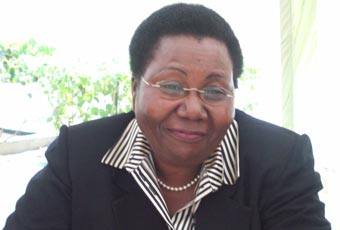
By Dicta Asiimwe
Uganda offers promises, Kenya pumps in money, Tanzania looks inward
In her 2010/11 Financial Year budget speech, Finance Minister Syda Bbumba said she envisages that the East African Community (EAC) Common Market which comes into force on July 1 will “stimulate greater productive efficiency, higher levels of domestic and foreign investment, increased employment, and growth of intra-regional trade and of extra-regional trade.”
Kenya’s Finance Minister, Uhuru Kenyatta, also spoke about how the Common Market would allow freedom of movement of goods, services, capital, business enterprises and skilled labour within the EAC.
While most EAC budgets did not show plans on how their economies are positioning to survive and thrive under the Common Market, Kenyatta unveiled a robust plan.
The Kenyan economy is far bigger than the combined economies of the other EAC states. Its budget shows that it is positioning itself to gain even more from the free flow of goods and services in the EAC.
Kenyatta announced a duo-pronged strategy that looked inwards with the “build Kenya, buy Kenya” theme and an outward looking strategy that ensures competitiveness abroad.
He proposed seven bills to support business expansion by cutting-down regulation and easing access to financing.
Kenyatta showed he was aware of the apprehension among other states. He said: “Kenya is prepared to fully implement the provisions of the Common Market protocol from 1st July, 2010. I also call upon our brothers on the community to do likewise”.

The Kenya budget was similar to the regional budgets in emphasising improving ease of doing business and investing in priority areas like infrastructure, energy, health, education, and agriculture. It also had a strong focus on the youth and Small and Medium Enterprises (SMEs).
But Kenyatta targeted the Common Market more directly. He allocated KShs 78.6 billion to the road sector. Of this, KShs700 million was to rehabilitate and construct the Voi-Taveta to transport goods into northern Tanzania and KShs 4.2 billion for roads to link up with Ethiopia and more for the standard gauge double railway from Mombasa to the Uganda border.
In contrast, Bbumba budgeted even less this year than shed did last year for roads – about Shs1 trillion. Last financial year, the sector had a bigger budget but major roads across the country remained in a poor state.
Industry
Kenya’s industries produce most of the goods consumed in the EAC. To spur the sector even further, Kenyatta removed duty on iron, cement petroleum coke, and on all industrial inputs used in manufacture of goods which are duty free in the EAC. To protect the sector he raised import duty on aluminum and cables from 10 percent to 25 percent. Most of these cuts were agreed on at the regional level. However, only the more industrialized Kenya and Tanzania are positioned to exploit them.
East African Budgets 2010/11 comparing Agriculture, Infrastructure and Energy
In a controversial move for regional producers, Kenyatta proposed lowering the rate on imported wheat from 35 percent to 10 percent and rice from 75 percent or US$200 per tonne to 35 percent. For years Kenya has riled EAC partner states because of its preferential treatment regarding the Common External Tariff and import duty on rice from Pakistan. Uganda and Tanzania say it stifles production and trade in locally grown rice and some rice imports in the region are illegally re-exported. Now Kenya appears set to import even more rice from Vietnam, China, and Iran under the same arrangement.
Tanzanian Finance Minister Mustafa Haidi Mkulo’s budget was a simplified version of Kenyatta’s. It was more specific.
It targeted mainly tax administration system and specific projects like implementation of Kilimo Kwanza, the National Identity Cards, land and the October 2010 General Election.
Other priorities were improving and expanding essential infrastructure services, including roads, railways, ports, airports and electricity projects.
Each of these priority areas was further broken down.

To improve tax collection the minister plans to strengthening the collection system, grade hotels, direct parastatals and other public institutions to remit to the Treasury surplus funds generated from their operations, and widen the tax base by registering new tax payers.
Under agriculture the minister proposed production of high quality seeds, provision of subsidy on farm inputs, improving market information system for farmers and developing marketing infrastructures. Other measures were construction of rain water harvesting dams to increase irrigation capacity and implementation of national land use plans.
Significantly, the minister proposed establishment of an Agricultural Bank and accelerate the implementation of agricultural financial leasing services.
The Finance ministers read the 2010/2011 budgets as their countries were preparing for general elections this year (Tanzania, Rwanda, Burundi), next year (Uganda), and in 2012 (Kenya). It was not surprising that they adopted a populist stance and did not increase taxes.
The ministers, however, needed to show how they would raise the revenues to finance the anticipated election year increase in public spending.
Total budget allocation for the three countries
Most increased their budget deficits and tabled plans to borrow more. However, Uganda, which has relied on donor aid to finance over 35 percent of the budget in the past, did not indicate where it would raise more money to fund up to 75 percent of the budget amidst donor aid cuts.
Kenyatta proposed to borrow aggressively in order to finance his budget. His proposals leave Kenya with a KShs188 billion deficit (Shs5, 207.6 billion).
Meanwhile, despite a decline in donor funding and the taxes, Uganda’s budget proposals leave a deficit of Shs2,000 billion. Rwanda’s deficit stands at Rwf140 billion (Shs504 billion).
Bbumba said Uganda would spend Shs7,553.3 billion where Shs5,640 billion is domestic funding and Shs1,912.1 billion is from donor funding. With a reduction in tax revenues and donor funding in this financial year, it is not clear how Uganda’s Finance minister plans to raise the extra money to finance a slightly expanded budget. In the 2009/10 FY, the Uganda Revenue Authority collected Shs160 billion less than the minister had projected. As a result, Uganda’s consolidated fund is in negative. But the minister projected an increase in projected revenue collection from Shs4,474.4 billion to Shs5,034.4 billion in the 2010/2011 financial year.
The shadow minister for Finance Oduman Okello said the tax authority would not meet the new target because the reasons that caused the failure to meet the targeted revenue still exist in addition to entering the common market.
Oduman warned that the government might have to contend with collapsing new industries in Uganda since the ones in Kenya had better economies of scale and cheaper inputs.
He accused the government of funding their cronies instead of preparing the country for joining the common market. “Government decided to sink money in the bottomless pit that is Phoenix Logistics instead of improving cotton production and give Nytil (currently called southern range Nyanza) raw materials for production of cloth,” Oduman said.
Youth targeted
Despite such fears, Bbumba made several political pitches. She reduced registration fees for motorcycles by Shs80, 000 from Shs222, 800 to Shs141, 400.
Bbumba also said the government had a programme called the Business and Enterprise Start-up Tools (BEST) clinic which had trained over 7000 youth and that 60-65% of them had business and were employing at least one youth. She also said she put aside some Shs 4 billion for lending out to graduates who have failed to get jobs at 5% interest rate per annum. This she said would allow the youth to create more jobs.
Many view this as a voting gambit. Uganda’s population is predominantly youthful and youth are a target for politicians seeking votes.
All budgets had a strong pitch for the youth. But Kenya’s projects for the youth are more institutionalized. Kenyatta proposed KShs1 billion for expansion of 26 technical schools, KShs 640 million for national polytechnics, and Shs560 million for science and technical institutes.
He injected KShs 3.8 billion into banks as a revolving fund from which young entrepreneurs could borrow. The banks match this up five times bring the total kitty to Kshs15 billion.
Most of these youth would also benefit from incentives offered to Small and Medium Enterprises regarding ease of starting a business, registering property, accessing credit, paying taxes and trading across borders.
Unfulfilled promises
Uganda should be comparatively advantaged in the agriculture sector. Bbumba said its centerpiece would remain National Agricultural Advisory Services (NAADS) programme which is designed to help farmers improve their crop, livestock, fisheries and apiculture (rearing bees).
The government has campaigned on the NAADS before. President Yoweri Museveni told rural smallholder famers that NAADS would enable each to earn Shs 20 million a year. It has not happened.
Bbumba said she was working with commercial banks to increase the agriculture credit facility from Shs60 billion to Shs90 billion. She said the banks had so far lent Shs 54 billion for people equipment for processing milk, maize and feed mills, tea processing plants and machinery, refrigeration equipment for meat processing and flowers and horticulture.
Kenyatta invested Kshs11.4 billion in fish farming and irrigation in rural areas alone. He exempted parent stock of chicken breeding from import duty and made capital expenditure of farm machinery 100 percent tax deductible.
Bbumba’s strategy appears to bank on anticipated dollars from the oil that has been discovered in parts of the country. She said the income tax law will be amended to provide a legal framework to integrate procedures for assessment and collection of petroleum revenues in the Income Tax Act.
“In the NRM we see an opportunity in oil, it won’t be a curse like some pessimists have said but a blessing,” the minister said. So far the oil deals have remained shrouded in secrecy that experts say bodes badly for any hopes of avoiding the oil curse. If that does not change, Bbumba’s budget might not have money to deliver her promises.
 The Independent Uganda: You get the Truth we Pay the Price
The Independent Uganda: You get the Truth we Pay the Price


